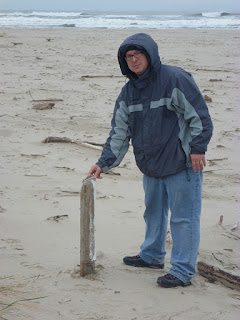Bayocean was to become the Atlantic City of the West. Bayoceans's post office was established on February 4, 1909, and by 1914, the town's population was 2000. Bayocean had many features uncommon for a small town of its time, including a dance hall, a hotel with orchestra, a 1000-seat movie theater, a shooting range, a bowling alley, tennis courts, a rail system and four miles of paved streets. One notable attraction was a heated natatorium (shown below), complete with a wave generator and a special section for a band to play music to entertain the swimmers.
Despite having paved roads, Bayocean was not connected to the rest of the country until the 1920s. Most residents and tourists arrived to the town via T. B. Potter's steamship, the S.S. Bayocean, in a three-day trip from Portland. The final leg of the journey, entering into the unprotected mouth of Tillamook Bay, could provide a rough and frightening experience to passengers.
Eventually Bayocean's residents asked the Army Corps of Engineers for a protective jetty to reduce the waves. The Army Corps of Engineers studied the location and suggested that two jetties be built, one on each side of the bay's mouth, at an estimated cost of $2.2 million. Half of that amount was required to come from local residents. With the multi-million dollar price considered unaffordable, Bayocean's residents proposed and eventually had a single jetty constructed. The price was a little over $800,000 with Bayocean's citizens paying half.
Although the new single jetty made for a much smoother journey into the bay, the one-sided change to the coastline began a process of erosion to Bayocean's beaches, slowly narrowing them before overtaking them completely.
In 1932, waves from a massive storm finally crossed the beach and destroyed the huge natatorium. The hotel started falling, room by room, into the sea. Each winter, the sea got further in. By 1938, 59 homes were gone. Finally, in the early 1950s, the sea breached the spit and rushed into Tillamook Bay, turning Bayocean into an island. Instantly, a multi-million-dollar oyster fishery was ruined, a thousand acres of oyster beds buried in sand. Salinity in the bay surged. The estuary’s fisheries started to collapse.Bayocean's post office closed in 1953. What little remained of the town was demolished during the reclamation and dike-building project of 1956. In 1960, Bayocean's last house was washed away, and in 1971, the last remaining building, a garage, finally fell into the ocean.
With the addition of a second jetty built in the 1970s, sand began to re-accumulate on the spit.
Luis and Mason at the south end of the spit.
With the addition of a second jetty built in the 1970s, sand began to re-accumulate on the spit.
Luis and Mason at the south end of the spit.
The high bluffs behind Mason held houses, buildings, and roads back in the day.
This seems like a good time to mention that we had no idea how long the walk along the Bayocean peninsula was. We just wanted to get further north as we knew that's where more of the town had been. Siena wasn't entirely on board with this walking idea.
She needed a little help. My back is still sore from offering this level of assistance.
A nice look at Bayocean today. If we were standing here 100 years ago, we would have seen a bustling town and dance hall here.
Luis examines an old board...probably just washed in from the sea but we liked to think it was a remnant of the old town.
The famous jetty's that did in the town.
We walked up the beach side of the peninsula and back on the Tillamook bay side of the peninsula.
Once we got back to the condo, we mapped out the distance of our little stroll. Our 3+ hour hike covered 7.5 miles!! Mason and Siena did AWESOME!! They certainly got tired but so did Luis and I and on the back stretch especially, they were little troopers. We were so proud, not to mention that we felt a little bad at having made our kids walk that distance.
After burning off all those calories, we made a beeline to the Tillamook Cheese Factory for a late lunch and ice cream. My little farmers had enough energy left to pose for a picture.
Despite having lunch at 4, we were hungry enough to have a Roadhouse 101 dinner at 7. Luis entertains Siena with the cool shell Siena and I found at Bayocean.
You can tell how big of partiers we are in that we were all in bed asleep by 10:30. No late night New Years partying for us this year.
We slowed down our pace for New Years day. We hung around the condo, watching football, playing and reading most of the morning. Mason and I did a little walk on the beach around the condo. He did his rock and log climbing.
Mason loves rock climbing, an activity that I recall enjoying a lot as a kid too.
He also liked exploring under the Mo's dock in the low tide.
We also stopped by some of the little shops in Taft on our way back.
We drove down to Newport for dinner New Year's day and found a great seafood restaurant on the far end of the old bay front. The name of the restaurant was generic sounding but the food certainly wasn't. Even the kids gobbled up their crabby patty and fish and chips.
We drove back today in time to watch the Ducks get the win over Wisconsin in the Rose Bowl. As Luis noted at the end of the game, the last time Oregon won in the Rose Bowl there was still at town of Bayocean!
Happy 2012 to all!


















2 comments:
I noticed I didn't comment on this so I will now:
Bayocean is a horrible name.
That needed to be said.
https://oregonencyclopedia.org/articles/bayocean/
https://www.theguardian.com/us-news/2015/apr/28/bayocean-american-city-disappeared-oregon
Post a Comment